Submitted:
26 June 2023
Posted:
27 June 2023
You are already at the latest version
Abstract
Keywords:
1. Introduction
2. Materials and Methods
3. Results
3.1. Milestones remote sensing-based AGGB retrieval
3.1.1. Sampling and analysis protocol for training and validation purposes
3.1.2. Grassland types covered in the reviewed studies
3.1.3. Geographical and temporal gradients covered
3.1.4. Platform & sensor configurations
3.1.5. Predictor variables commonly used in AGGB studies
| Variable name | Expression/spectral bands | Example study |
| Backscatter | HH | Ali et al. (2017) |
| Canopy Sward Height | N/A | Wijesingha et al. (2019) |
| Enhanced Vegetation Index (EVI) | (R851 – R655)/( R851 + 6R655-7.8R482+1) | Meng et al. (2020) |
| Fraction of Photosynthetically Active Radiation (FAPAR) | FAPAR = 1-t-r+trs | Schmidt et al. (2016) |
| Modified Soil-Adjusted Vegetation Index (MSAVI) | [2NIR + 1 − ((2NIR + 1)2 − 8(NIR − R)) 0.5]/2 | Jiang et al. (2015) |
| Normalised Difference Vegetation Index (NDVI) | NDVI = − (infrared band - red band)/(infrared band + red band) | Ikeda et al. (1999) |
| Normalised Band Depth Index (NBDI) | NBDI = BD − Dc/BD + D | Ullah et al. (2012) |
| Ratio Vegetation Index (RVI) | RVI = NIR/ Red | Ding et al. (2019) |
| Red edge-based NDVI | (R750 – R705)/( R750 + R705) | Li and Guo (2018) |
| Red edge-based Simple Ratio | (R708 – R755)/( R708 + R755) | Mutanga and Skidmore (2004) |
| Simple Ratio (SR) | SR = NIR/ Red | Ren and Feng (2015) |
| Soil-Adjusted Vegetation Index (SAVI) | 1 + L x (RNIR – RRED)/(RNIR +RRED) + L | Ren and Feng, (2015) |
| 2 RNIR is the reflectance in the Near Infrared band, RRed is the reflectance in the Red band. | ||
3.2. Algorithms commonly used in remote sensing-based AGGB studies
4. Discussion
4.1. Milestones remote sensing-based AGGB retrieval
4.1.1. Sampling and analysis protocol for training and validation purposes
4.1.2. Geographical and temporal gradients covered
4.1.3. Platform and Sensor configurations
4.1.4. Predictor variables
4.1.5. Algorithms developed
4.1.6. Sampling and analysis protocols
4.2. Research Challenges and Outlook
4.2.1. Research challenges
4.2.2. Limitations of the study
4.2.3. Research outlook
- Developed countries contributed more research on remote sensing-based AGGB compared to developing countries. As such, more research should be done in the global south in order to promote an all-inclusive regional reporting.
- Few studies applied remote sensors operating outside the optical channel of the electromagnetic spectrum (i.e. microwave) for retrieving AGGB. Specifically, Radar-derived metrics could add tangible value to the performance of biomass estimation models. The freely available Sentinel-1 offers an opportunity to quantify AGGB in Savannah ecosystems.
- The integration of Radar images shows promising results and a further exploration of the complimentary aspect of these sensors should improve the baseline models.
- Although costly, Lidar datasets seem promising in terms of accuracy and further studies should explore their full potential in AGGB estimation.
- Despite their limitation, vegetation indices remain as major predictor variables. Thus, improved accuracies of estimating AGGB may be realised with the incorporation of supplementary variables such as sward height, FAPAR, agro-meteorological and topographical variables.
- From a Radar perspective, soil moisture and soil roughness should be taken into consideration during modelling since they contaminate the backscattering processes.
- Many researchers have relied on the less transferable linear regression while machine-learning approaches have not been fully explored. However, deep learning algorithms are emerging as the new dawn of algorithms and their utility in AGGB estimation is in its infancy, thereby leaving a gap for further research.
- The mismatch between the estimating and validation scale reduces the accuracy of estimating AGGB. The lack of consistency between in-situ measurement and sampling protocol further hinders comparability across the studies. This signals the need to benchmark the sampling process.
- It is also of interest to explore the use of the newly launched Sentinel-3 and Landsat-9 OLI in quantifying AGGB in Savannah ecosystems.
- Future research on AGGB estimation should focus on the application of multi-source data and multi-temporal data available via cloud-based applications, including GEE, Microsoft Azure and Amazon Web Services (AWS).
5. Conclusions
Author Contributions
Funding
Institutional Review Board Statement
Informed Consent Statement
Data Availability Statement
Acknowledgments
Conflicts of Interest
Appendix A
| Authors | Journal Name | Year |
|---|---|---|
| Ali, I; Barrett, B; Cawkwell, F; Green, S; Dwyer, E; Neumann, M | IEEE Journal of Selected Topics in Applied Earth Observations and Remote Sensing | 2017 |
| Ali, I; Cawkwell, F; Dwyer, E; Green, S | IEEE Journal of Selected Topics in Applied Earth Observations and Remote Sensing | 2016 |
| An, N; Price. KP; Blair, JM | International Journal of Remote Sensing | 2013 |
| Bao, N; Li, W; Gu, X; Liu, Y | Remote Sensing | 2019 |
| Barrachina, M; Cristobal, J; Tulla, AF | International Journal of Applied Earth Observation and Geoinformation | 2015 |
| Braun, A;Wagner, J; Hochschild, V | Journal of Applied Remote Sensing | 2018 |
| Butterfield, HS; Malmstrom, CM | International Journal of Remote Sensing | 2009 |
| Chen, J; Gu, S; Shen, M; Tang, Y; Matsushita, B | International Journal of Remote Sensing | 2009 |
| Cho, MA; Skidmore, AK | International Journal of Remote Sensing | 2013 |
| Cicore, P; Serrano, J; Shahidian, S; Sousa A; Costa, JL; Da Silva, JRM | Environmental Monitoring and Assessment | 2016 |
| Cisneros, A; Fiorio, P; Menezes, P; Pasqualotto, N; Van Wittenberghe, S; Bayma, G; Nogueira, SF | Agronomy-Basel | 2020 |
| Clevers, JGPW; Van der Heijden, GWAM; Verzakov, S; Schaepman, ME | Photogrammetric Engineering & Remote Sensing | 2007 |
| Cooper, SD; Roy, DP; Schaaf, CB; Paynter, I. | Remote Sensing | 2017 |
| Ding, L; Li, Z;Wang, X; Yan, R; Shen, B; Chen, B; Xin, X | Sensors | 2019 |
| Diouf A.A., Hiernaux P., Brandt M., Faye G., Djaby, B; Diop M.B., Ndione J.A., Tychon B. | Remote Sensing | 2016 |
| Duan, M, Gao, Q, Wan, Y, Li, Y, Guo, Y, Ganzhu, Z, & Qin, X | Canadian Journal of Remote Sensing | 2011 |
| Durante, M; Oesterheld, M; Pineiro, G; Vassallo, MM | International Journal of Remote Sensing | 2014 |
| Dusseux, P; Hubert-Moy, L; Corpetti, T; Vertès, F | International Journal of Applied Earth Observation and Geoinformation | 2015 |
| Egeru, A; Wasonga, O; Kyagulanyi, J; Majaliwa, GJ; MacOpiyo, L; Mburu, J | Pastoralism | 2014 |
| Fajji, NG; Palamuleni, LG; Mlambo, V | South African Journal of Geomatics | 2017 |
| Fatehi, P; Damm, A; Schweiger, AK; Schaepman, ME; Kneubühler, M | IEEE Journal of Selected Topics in Applied Earth Observations and Remote Sensing | 2015 |
| Flynn, ES; Dougherty, CT; Wendroth, O | Agronomy Journal | 2008 |
| Friedl, MA; Schimel, DS; Michaelsen, J; Davis, FW; Walker, H | International Journal of Remote Sensing | 1994 |
| Frolking, S; Fahnestock, M; Milliman, T; Mcdonald, K; Kimball, J | Geophysical Research Letters | 2005 |
| Gao, JX; Chen, YM; Lü, SH; Feng, CY; Chang, XL; Ye, SX; Liu, JD | International Journal of Remote Sensing | 2012 |
| Gao, T; Xu, B;Yang, X; Jin, Y; Ma, H; Li, J; Yu, H | International Journal of Remote Sensing | 2012 |
| Gao, X; Dong, S;Li, S; Xu, Y; Liu, S; Zhao, H; Yeomans, J;Li, Y; Shen, H; Wu, S; Zhi, Y | Ecological Indicators | 2020 |
| Gianelle, D; Vescovo, L; Mason, F | International Journal of Wildland Fire | 2009 |
| Gianelle, DAMIANO; Guastella, FB; | International Journal of Remote Sensing | 2010 |
| Gruner, E; Astor, T; Wachendorf, M | Agronomy-Basel | 2019 |
| Guerini Filho, M; Kuplich, TM; Quadros, FLD | International Journal of Remote Sensing | 2020 |
| Hajj, ME; Baghdadi, N; Belaud, G; Zribi, M; Cheviron, B; Courault, D; Hagolle, O; Charron, F | Remote Sensing | 2014 |
| He, L; Li, A; Yin, G; Nan, X; Bian, J | Remote Sensing | 2019 |
| Ikeda, H; Okamoto, K; Fukuhara, M; | International Journal of Remote Sensing | 1999 |
| Jansen, VS; Kolden, CA; Schmalz HJ | Remote Sensing | 2018 |
| Jia, W; Liu, M; Yang, Y; He, H; Zhu, X; Yang, F; Yin, C; Xiang, W | Ecological Indicators | 2016 |
| Jiang, YB; Tao, J; Huang, YQ; Zhu, JT; Tian, L; Zhang, YJ | Journal of Plant Ecology | 2015 |
| Jin, Y; Yang, X; Qiu, J; Li, J; Gao, T; Wu, Q; Zhao, F; Ma, H; Yu, H; Xu, B | Remote Sensing | 2014 |
| Justice BO; Hiernaux PHY | International Journal of Remote Sensing | 1986 |
| Kawamura, K; Betteridge, K; Sanches, ID; Tuohy, MP; Costall, D; Inoue, Y | New Zealand Journal of Agricultural Research | 2009 |
| Li, C; Wulf, H; Schmid, B; He, JS; Schaepman, ME | IEEE Journal of Selected Topics in Applied Earth Observations And Remote Sensing | 2018 |
| Li, F; Zeng, Y;Luo, J; Ma, R; Wu, B | Ecological Indicators | 2016 |
| Li, Z; Guo, X | Canadian Journal of Remote Sensing | 2017 |
| Li, ZQ; Guo, XL | International Journal of Remote Sensing | 2018 |
| Liang, T; Yang, S; Feng, Q; Liu, ; Zhang, R; Huang, X; & Xie, H | Remote Sensing of Environment | 2016 |
| Liu, S; Su, X; Dong, S; Cheng, F; Zhao, H; Wu, X; & Li, J. | Giscience & Remote Sensing | 2015 |
| Lussem, U; Schellberg, J; Bareth, G | PFG–Journal of Photogrammetry, Remote Sensing and Geoinformation Science | 2007 |
| Marabel, M, & Alvarez-Taboada, F | Sensors | 2008 |
| Meng, B; Ge, J; Liang, T; Yang, S; Gao, J; Feng, Q; Cui, X; Huang, X; Xie, H | Remote Sensing | 2015 |
| Meng, B; Liang, T; Yi, S; Yin, J; Cui, X; Ge, J; Hou, M; Lv, Y; Sun, Y | IEEE Journal of Selected Topics in Applied Earth Observations and Remote Sensing | 2020 |
| Meshesha, DT; Ahmed, MM; Abdi, DY; Haregeweyn, N | Heliyon | 2020 |
| Moeckel, T; Safari, H; Reddersen, B; Fricke, T; Wachendorf, M | Remote Sensing | 2017 |
| Moreau, S; Le Toan, T | Remote Sensing of Environment | 2003 |
| Mutanga, O; Rugege, D | International Journal of Remote Sensing | 2006 |
| Mutanga, O; Skidmore, AK | International Journal of Applied Earth Observation And Geoinformation | 2004 |
| Mutanga, O; Skidmore, AK | International Journal of Remote Sensing | 2004 |
| Naidoo, L; Van Deventer, H;Ramoelo, A; Mathieu, R; Nondlazi, B, Gangat, R | International Journal of Applied Earth Observation and Geoinformation | 2019 |
| Olsen, JL; Miehe, S; Ceccato, P; Fensholt, R | Biogeosciences | 2015 |
| Otgonbayar, M; Atzberger, C; Chambers, J; Damdinsuren, A | International Journal of Remote Sensing | 2019 |
| Prince SD; Tucker, CJ | International Journal of Remote Sensing | 1986 |
| Psomas, A, Kneubühler, M, Huber, S, Itten, K, Zimmermann, NE | International Journal of Remote Sensing | 2011 |
| Punalekar, SM; Verhoef, A; Quaife, TL; Humphries, D; Bermingham, L; Reynolds, CK | Remote Sensing of Environment | 2018 |
| Quan, X; He, B; Yebra, M; Yin, C; Liao, Z; Zhang, X; Li, X | International Journal of Applied Earth Observation and Geoinformation | 2017 |
| Ramoelo, A; Cho, MA; Mathieu, R; Madonsela, S; Van De Kerchove, R; Kaszta, Z; Wolff, E | International Journal of Applied Earth Observation and Geoinformation | 2015 |
| Ren, H; Feng, G; | Grass and Forage Science | 2015 |
| Sang, H; Zhang, J; Lin, H; Zhai, L | Remote Sensing | 2014 |
| Sarrazin, MJD; Van Aardt, JAN; Asner, GP; Mcglinchy, J; Messinger, DW; Wu, J | Canadian Journal of Remote Sensing | 2011 |
| Schino, G; Borfecchia, F; De Cecco, L; Dibari, C; Iannetta, M; Martini, S; Pedrotti, F | Agroforestry Systems | 2008 |
| Schmidt, M; Carter, J; Stone, G; O’Reagain, P | Remote Sensing | 2016 |
| Schulze-Brüninghoff, D; Hensgen, F; Wachendorf, M; Astor, T | Computers and Electronics in Agriculture | 2019 |
| Schweiger, AK; Risch, AC; Damm, A; Kneubuhler, M; Haller, R; Schaepman, ME; Schutz, M | Journal of Vegetation Science | 2015 |
| Schwieder, M; Buddeberg, M; Kowalski, K; Pfoch, K; Bartsch, J; Bach, H; Pickert, J; Hostert, P | PFG-Journal of Photogrammetry Remote Sensing and Geoinformation Science | 2020 |
| Shen, M; Tang, Y; Klein, J; Zhang, P; Gu, S; Shimono, A; Chen, J | Journal of Plant Ecology | 2008 |
| Shoko, C; Mutanga, O; Dube, T | Remote Sensing | 2013 |
| Shoko, O Mutanga, T Dube | International Journal of Applied Earth Observation and Geoinformation | 2018 |
| Sibanda, M; Mutanga, O; Rouget, M | Giscience & Remote Sensing | 2016 |
| Sibanda, M; Mutanga, O; Rouget, M | ISPRS Journal of Photogrammetry and Remote Sensing | 2015 |
| Sibanda, M; Mutanga, O; Rouget, M; Kumar, L | Remote Sensing | 2017 |
| Svoray, T; Shoshany, M; | International Journal of Remote Sensing | 2002 |
| Ullah, S; Si, Y; Schlerf, M; Skidmore, A.K; Shafique, M; Iqbal, IA | International Journal of Applied Earth Observation and Geoinformation | 2012 |
| Vanamburg, LK; Trlica, MJ; Hoffer, RM; Weltz, MA | International Journal of Remote Sensing | 2006 |
| Verbesselt, J; Somers, B; van Aardt, J.A.N; Jonckheere, I; Coppin, P | Remote Sensing of Environment | 2006 |
| Vescovo, L; Gianelle, D | Advances in Space Research | 2008 |
| Vogel, S; Gebbers, R; Oertel, M; Kramer, E | Sensors | 2019 |
| Wang, CY; Price, KP; Merwe, D; An, N; Wang, H | Photogrammetric Engineering & Remote Sensing | 2014 |
| Wang, D, Xin, X, Shao, Q, Brolly, M, Zhu, Z, Chen, J | Sensors | 2017 |
| Wang, G; Liu, S; Liu, T; Fu, Z; Yu, J; Xue, B | International Journal of Remote Sensing | 2019 |
| Wang, J; Xiao, X; Bajgain, R; Starks, P; Steiner, J; Doughty, RB; Chang, Q | ISPRS Journal of Photogrammetry And Remote Sensing | 2019 |
| Wang, X; Dong, J; Baoyin, T; Bao, Y | Sustainability | 2019 |
| Wang, X; Ge, L; Li, X; Gherardi, S | Photogrammetric Engineering & Remote Sensing | 2014 |
| Wang, Y; Wu, G; Deng, L;Tang, Z; Wang, K; Sun, W; Shangguan, Z | Scientific Reports | 2017 |
| Wehlage, DC; Gamon, JA; Thayer, D; Hildebrand, DV | Remote Sensing | 2016 |
| Wessels, KJ; Prince, SD; Zambatis, N; MacFadyen, S; Frost, PE; Van Zyl, D | International Journal of Remote Sensing | 2006 |
| Wijesingha, J, Moeckel, T, Hensgen, F, & Wachendorf, M | International Journal of Applied Earth Observation and Geoinformation | 2019 |
| Wylie, BK; Meyer, DJ; Tieszen, LL; Mannel, S | Remote Sensing of Environment | 2009 |
| Xie, Y; Sha, Z; Yu, M; Bai, Y; Zhang, L | Ecological Modelling | 2009 |
| Xing, M; He, B; Li, X | Journal of Applied Remote Sensing | 2014 |
| Yan, F;Wu, B;Wang, Y. | Journal Of Arid Land | 2013 |
| Yang, S; Feng, Q; Liang, T; Liu, B; Zhang, W; Xie, H | Remote Sensing of Environment | 2018 |
| Yin, G; Li, A; Wu, C; Wang, J; Xie, Q; Zhang, Z; Nan, X; Jin, H; Bian, J; Lei, G | ISPRS International Journal of Geo-Information | 2018 |
| Yin, X; Wang, C; Zong, Z; Wang, H; Zhang, ; Zhang, W | Spectroscopy Letters | 2018 |
| Zeng, N; He, H; Ren, X; Zhang, L; Zeng, Y; Fan, J; Li, Y; Niu, Z; Zhu, X; Chang, Q | International Journal of Remote Sensing | 2020 |
| Zeng, N; Ren, X; He, H; Zhang, L; Li, P; Li, Z; Zhang, L | Research of Environmental Sciences | 2017 |
| Zeng, N; Ren, X; He, H; Zhang, L; Zhao, D; Ge, R; Niu, Z | Ecological Indicators | 2019 |
| Zhang, B; Zhang, L; Xie, D; Yin, X; Liu, C; Liu, G | Remote Sensing | 2016 |
| Zhang, H; Sun, Y; Chang, L; Qin, Y; Chen, J; Qin, Y; Du J; Yi, S, Wang, Y | Remote Sensing | 2018 |
| Zhang, X; Chen, X; Tian, M; Fan, Y; Ma, J; Xing, D | Plos One | 2020 |
| Zhao, F; Xu, B; Yang, X; Jin, Y; Li, J; Xia, L; Chen, S; Ma, H | Remote Sensing | 2014 |
References
- Adjorlolo, C., Mutanga. "Challenges and opportunities in the use of remote sensing for C3 and C4 grass species discrimination and mapping.". African Journal of Range & Forage Science 2012, 29, 47–61. [Google Scholar]
- Ali, I., Barrett. Application of repeat-pass TerraSAR-X staring spotlight interferometric coherence to monitor pasture biophysical parameters: limitations and sensitivity analysis. IEEE Journal of Selected Topics in Applied Earth Observations and Remote Sensing 2017, 10, 3225–3231. [Google Scholar] [CrossRef]
- Ali, I.; Cawkwell, F.; Dwyer, E.; Green, S. Modeling Managed Grassland Biomass Estimation by Using Multitemporal Remote Sensing Data—A Machine Learning Approach. IEEE J. Sel. Top. Appl. Earth Obs. Remote. Sens. 2016, 10, 3254–3264. [Google Scholar] [CrossRef]
- Ali, I.; Greifeneder, F.; Stamenkovic, J.; Neumann, M.; Notarnicola, C. Review of Machine Learning Approaches for Biomass and Soil Moisture Retrievals from Remote Sensing Data. Remote. Sens. 2015, 7, 16398–16421. [Google Scholar] [CrossRef]
- Bannari, A.; Morin, D.; Bonn, F.; Huete, A.R. A review of vegetation indices. Remote Sens. Rev. 1995, 13, 95–120. [Google Scholar] [CrossRef]
- Bao, N.; Li, W.; Gu, X.; Liu, Y. Biomass Estimation for Semiarid Vegetation and Mine Rehabilitation Using Worldview-3 and Sentinel-1 SAR Imagery. Remote. Sens. 2019, 11, 2855. [Google Scholar] [CrossRef]
- Barrett, B.; Nitze, I.; Green, S.; Cawkwell, F. Assessment of multi-temporal, multi-sensor radar and ancillary spatial data for grasslands monitoring in Ireland using machine learning approaches. Remote. Sens. Environ. 2014, 152, 109–124. [Google Scholar] [CrossRef]
- Braun, A.; Wagner, J.; Hochschild, V. Above-ground biomass estimates based on active and passive microwave sensor imagery in low-biomass savanna ecosystems. J. Appl. Remote. Sens. 2018, 12, 046027. [Google Scholar] [CrossRef]
- Butterfield, H.S.; Malmström, C.M. The effects of phenology on indirect measures of aboveground biomass in annual grasses. Int. J. Remote. Sens. 2009, 30, 3133–3146. [Google Scholar] [CrossRef]
- Calleja, J.F.; Pagés, O.R.; Díaz-Álvarez, N.; Peón, J.; Gutiérrez, N.; Martín-Hernández, E.; Relea, A.C.; Melendi, D.R.; Álvarez, P.F. Detection of buried archaeological remains with the combined use of satellite multispectral data and UAV data. Int. J. Appl. Earth Obs. Geoinf. 2018, 73, 555–573. [Google Scholar] [CrossRef]
- Chave, J.; Davies, S.J.; Phillips, O.L.; Lewis, S.L.; Sist, P.; Schepaschenko, D.; Armston, J.; Baker, T.R.; Coomes, D.; Disney, M.; et al. Ground Data are Essential for Biomass Remote Sensing Missions. Surv. Geophys. 2019, 40, 863–880. [Google Scholar] [CrossRef]
- Chen, X.; Hutley, L.B.; Eamus, D. Carbon balance of a tropical savanna of northern Australia. Oecologia 2003, 137, 405–416. [Google Scholar] [CrossRef]
- Debastiani, A.B.; Sanquetta, C.R.; Corte, A.P.D.; Pinto, N.S.; Rex, F.E. Evaluating SAR-optical sensor fusion for aboveground biomass estimation in a Brazilian tropical forest. Ann. For. Res. 2019, 62, 109–122. [Google Scholar] [CrossRef]
- Ding, L. , Li, Z. , Wang, X., Yan, R., Shen, B., Chen, B. and Xin, X. "Estimating grassland carbon stocks in Hulunber China, using Landsat8 oli imagery and regression kriging." Sensors 2019, 19, 5374. [Google Scholar]
- Donlon, C.; Berruti, B.; Buongiorno, A.; Ferreira, M.-H.; Féménias, P.; Frerick, J.; Goryl, P.; Klein, U.; Laur, H.; Mavrocordatos, C.; et al. The Global Monitoring for Environment and Security (GMES) Sentinel-3 mission. Remote. Sens. Environ. 2012, 120, 37–57. [Google Scholar] [CrossRef]
- Eisfelder, C.; Kuenzer, C.; Dech, S. Derivation of biomass information for semi-arid areas using remote-sensing data. Int. J. Remote Sens. 2012, 33, 2937–2984. [Google Scholar] [CrossRef]
- FAO. Challenges and opportunities for carbon sequestration in grassland systems. A technical report on grassland management and climate change mitigation. Integrated Crop Management, Food and Agriculture Organization of the United Nations 2010, 9, 1–57. [Google Scholar]
- Fiala, K. Belowground plant biomass of grassland ecosystems and its variation according to ecological factors. Ekologia 2010, 29, 182–206. [Google Scholar] [CrossRef]
- Frolking, S.; Fahnestock, M.; Milliman, T.; McDonald, K.; Kimball, J. Interannual variability in North American grassland biomass/productivity detected by SeaWinds scatterometer backscatter. Geophys. Res. Lett. 2005, 32. [Google Scholar] [CrossRef]
- Ghasemi, N. , Sahebi, M. R. and Mohammadzadeh, A. "A review on biomass estimation methods using synthetic aperture radar data." International Journal of Geomatics and Geosciences 2011, 1, 776. [Google Scholar]
- Ghosh, P. and Mahanta, S. "Carbon sequestration in grassland systems." Range Management and Agroforestry 2014, 35, 173–181. [Google Scholar]
- Hajj, M. E. , Baghdadi, N. , Belaud, G., Zribi, M., Cheviron, B., Courault, D., Hagolle, O. and Charron, F. "Irrigated grassland monitoring using a time series of terraSAR-X and COSMO-skyMed X-Band SAR Data." Remote Sensing 2014, 6, 10002–10032. [Google Scholar]
- Hamdan, O., Hasmadi. "L-band saturation level for aboveground biomass of dipterocarp forests in peninsular Malaysia.". Journal of Tropical Forest Science 2015, 388–399. [Google Scholar]
- Ikeda, H.; Okamoto, K.; Fukuhara, M. Estimation of aboveground grassland phytomass with a growth model using Landsat TM and climate data. Int. J. Remote. Sens. 1999, 20, 2283–2294. [Google Scholar] [CrossRef]
- Intergovernmental Panel on Climate Change, I. Guidelines for national greenhouse gas inventories: agriculture, forestry and other land use. Geneva, National Greenhouse Gas Inventories Programme. 2006.
- Jiang, Y.; Tao, J.; Huang, Y.; Zhu, J.; Tian, L.; Zhang, Y. The spatial pattern of grassland aboveground biomass on Xizang Plateau and its climatic controls. J. Plant Ecol. 2014, 8, 30–40. [Google Scholar] [CrossRef]
- Joshi, N.; Baumann, M.; Ehammer, A.; Fensholt, R.; Grogan, K.; Hostert, P.; Jepsen, M.R.; Kuemmerle, T.; Meyfroidt, P.; Mitchard, E.T.A.; et al. A Review of the Application of Optical and Radar Remote Sensing Data Fusion to Land Use Mapping and Monitoring. Remote. Sens. 2016, 8, 70. [Google Scholar] [CrossRef]
- Keith, A. Marill, M. D. "Advanced Statistics: Linear Regression,Part I: Simple Linear Regression." Wiley Online Library 2004, 11.
- Kumar, L.; Mutanga, O. Remote Sensing of Above-Ground Biomass. Remote. Sens. 2017, 9, 935. [Google Scholar] [CrossRef]
- Kumar, L.; Sinha, P.; Taylor, S.; Alqurashi, A.F. Review of the use of remote sensing for biomass estimation to support renewable energy generation. J. Appl. Remote. Sens. 2015, 9, 097696–097696. [Google Scholar] [CrossRef]
- Li, M.; Zang, S.; Zhang, B.; Li, S.; Wu, C. A Review of Remote Sensing Image Classification Techniques: the Role of Spatio-contextual Information. Eur. J. Remote Sens. 2014, 47, 389–411. [Google Scholar] [CrossRef]
- Li, Z. and Guo, X. "Can Polarimetric Radarsat-2 Images Provide a Solution to Quantify Non-Photosynthetic Vegetation Biomass in Semiarid Mixed Grassland?" Canadian Journal of Remote Sensing 2017, 43, 593–607. [Google Scholar]
- Li, Z. and Guo, X. "Non-photosynthetic vegetation biomass estimation in semiarid Canadian mixed grasslands using ground hyperspectral data, Landsat 8 OLI, and Sentinel-2 images." International Journal of Remote Sensing 2018, 39, 6893–6913. [Google Scholar]
- Liang, T.; Yang, S.; Feng, Q.; Liu, B.; Zhang, R.; Huang, X.; Xie, H. Multi-factor modeling of above-ground biomass in alpine grassland: A case study in the Three-River Headwaters Region, China. Remote. Sens. Environ. 2016, 186, 164–172. [Google Scholar] [CrossRef]
- Lu, D. The potential and challenge of remote sensing-based biomass estimation. Int. J. Remote. Sens. 2006, 27, 1297–1328. [Google Scholar] [CrossRef]
- Ma, W.; Fang, J.; Yang, Y.; Mohammat, A. Biomass carbon stocks and their changes in northern China’s grasslands during 1982–2006. Sci. China Life Sci. 2010, 53, 841–850. [Google Scholar] [CrossRef]
- Maesano, M.; Khoury, S.; Nakhle, F.; Firrincieli, A.; Gay, A.; Tauro, F.; Harfouche, A. UAV-Based LiDAR for High-Throughput Determination of Plant Height and Above-Ground Biomass of the Bioenergy Grass Arundo donax. Remote. Sens. 2020, 12, 3464. [Google Scholar] [CrossRef]
- Masenyama, A.; Mutanga, O.; Dube, T.; Bangira, T.; Sibanda, M.; Mabhaudhi, T. A systematic review on the use of remote sensing technologies in quantifying grasslands ecosystem services. GIScience Remote. Sens. 2022, 59, 1000–1025. [Google Scholar] [CrossRef]
- Mavridou, A.; Pappa, O.; Papatzitze, O.; Dioli, C.; Kefala, A.M.; Drossos, P.; Beloukas, A. Exotic Tourist Destinations and Transmission of Infections by Swimming Pools and Hot Springs—A Literature Review. Int. J. Environ. Res. Public Heal. 2018, 15, 2730. [Google Scholar] [CrossRef]
- Meng, B.; Liang, T.; Yi, S.; Yin, J.; Cui, X.; Ge, J.; Hou, M.; Lv, Y.; Sun, Y. Modeling Alpine Grassland Above Ground Biomass Based on Remote Sensing Data and Machine Learning Algorithm: A Case Study in East of the Tibetan Plateau, China. IEEE J. Sel. Top. Appl. Earth Obs. Remote. Sens. 2020, 13, 2986–2995. [Google Scholar] [CrossRef]
- Mishra, N. B. and Young, K. R. Savannas and grasslands. Terrestrial Ecosystems and Biodiversity, CRC Press: 2020, 235-247.
- Moreau, S.; Le Toan, T. Biomass quantification of Andean wetland forages using ERS satellite SAR data for optimizing livestock management. Remote. Sens. Environ. 2003, 84, 477–492. [Google Scholar] [CrossRef]
- Mutanga, O.; Dube, T.; Ahmed, F. Progress in remote sensing: vegetation monitoring in South Africa. South Afr. Geogr. J. 2016, 98, 461–471. [Google Scholar] [CrossRef]
- Mutanga, O.; Skidmore, A.K. Narrow band vegetation indices overcome the saturation problem in biomass estimation. Int. J. Remote Sens. 2004, 25, 3999–4014. [Google Scholar] [CrossRef]
- Naidoo, L.; van Deventer, H.; Ramoelo, A.; Mathieu, R.; Nondlazi, B.; Gangat, R. Estimating above ground biomass as an indicator of carbon storage in vegetated wetlands of the grassland biome of South Africa. Int. J. Appl. Earth Obs. Geoinformation 2019, 78, 118–129. [Google Scholar] [CrossRef]
- Odebiri, O.; Odindi, J.; Mutanga, O. Basic and deep learning models in remote sensing of soil organic carbon estimation: A brief review. Int. J. Appl. Earth Obs. Geoinformation 2021, 102. [Google Scholar] [CrossRef]
- Osborne, C. P. , Charles-Dominique, T. , Stevens, N., Bond, W. J., Midgley, G. and Lehmann, C. E. "Human impacts in African savannas are mediated by plant functional traits." New Phytologist 2018, 220, 10–24. [Google Scholar]
- Oyewole, S. Space Research and Development in Africa. Astropolitics 2017, 15, 185–208. [Google Scholar] [CrossRef]
- Parr, C. L. , Lehmann, C. E., Bond, W. J., Hoffmann, W. A. and Andersen, A. N. "Tropical grassy biomes: misunderstood, neglected, and under threat." Trends in ecology & evolution 2014, 29, 205–213. [Google Scholar]
- Pritt, M. and Chern, G. "Satellite image classification with deep learning." Proceedings - Applied Imagery Pattern Recognition Workshop 2017-October. 2018. [Google Scholar]
- Prudente, V.H.R.; Martins, V.S.; Vieira, D.C.; Silva, N.R.d.F.e.; Adami, M.; Sanches, I.D. Limitations of cloud cover for optical remote sensing of agricultural areas across South America. Remote. Sens. Appl. Soc. Environ. 2020, 20, 100414. [Google Scholar] [CrossRef]
- Ren, H. and Feng, G. "Are soil-adjusted vegetation indices better than soil-unadjusted vegetation indices for above-ground green biomass estimation in arid and semi-arid grasslands?" Grass and Forage Science 2015, 70, 611–619. [Google Scholar]
- Ren, H.; Zhou, G. Estimating senesced biomass of desert steppe in Inner Mongolia using field spectrometric data. Agric. For. Meteorol. 2012, 161, 66–71. [Google Scholar] [CrossRef]
- Ricard, M.F.; Berhongaray, G.; Viglizzo, E.F. The Argentine Pampas: A Novel Ecosystem at the Crossroad. 2019. [Google Scholar] [CrossRef]
- Sánchez-Azofeifa, G.A.; Castro-Esau, K.L.; Kurz, W.A.; Joyce, A. Monitoring carbon stocks in the tropics and the remote sensing operational limitations: from local to regional projects. Ecol. Appl. 2009, 19, 480–494. [Google Scholar] [CrossRef]
- Sang, H.; Zhang, J.; Lin, H.; Zhai, L. Multi-Polarization ASAR Backscattering from Herbaceous Wetlands in Poyang Lake Region, China. Remote. Sens. 2014, 6, 4621–4646. [Google Scholar] [CrossRef]
- Sarrazin, M.; van Aardt, J.; Asner, G.; McGlinchy, J.; Messinger, D.; Wu, J. Fusing small-footprint waveform LiDAR and hyperspectral data for canopy-level species classification and herbaceous biomass modeling in savanna ecosystems. Can. J. Remote. Sens. 2011, 37, 653–665. [Google Scholar] [CrossRef]
- Schmidt, M.; Pringle, M.; Devadas, R.; Denham, R.; Tindall, D. A Framework for Large-Area Mapping of Past and Present Cropping Activity Using Seasonal Landsat Images and Time Series Metrics. Remote. Sens. 2016, 8, 312. [Google Scholar] [CrossRef]
- Scurlock, J.M.O.; Hall, D.O. The global carbon sink: a grassland perspective. Glob. Chang. Biol. 1998, 4, 229–233. [Google Scholar] [CrossRef]
- Sharifi, A.; Mahdipour, H.; Moradi, E.; Tariq, A. Agricultural Field Extraction with Deep Learning Algorithm and Satellite Imagery. J. Indian Soc. Remote. Sens. 2022, 50, 417–423. [Google Scholar] [CrossRef]
- Shoko, C.; Mutanga, O.; Dube, T. Progress in the remote sensing of C3 and C4 grass species aboveground biomass over time and space. ISPRS J. Photogramm. Remote. Sens. 2016, 120, 13–24. [Google Scholar] [CrossRef]
- Shoko, C.; Mutanga, O.; Dube, T. Determining Optimal New Generation Satellite Derived Metrics for Accurate C3 and C4 Grass Species Aboveground Biomass Estimation in South Africa. Remote. Sens. 2018, 10, 564. [Google Scholar] [CrossRef]
- Shoko, C.; Mutanga, O.; Dube, T.; Slotow, R. Characterizing the spatio-temporal variations of C3 and C4 dominated grasslands aboveground biomass in the Drakensberg, South Africa. Int. J. Appl. Earth Obs. Geoinformation 2018, 68, 51–60. [Google Scholar] [CrossRef]
- Sibanda, M.; Mutanga, O.; Rouget, M. Comparing the spectral settings of the new generation broad and narrow band sensors in estimating biomass of native grasses grown under different management practices. GIScience Remote. Sens. 2016, 53, 614–633. [Google Scholar] [CrossRef]
- Sinha, S. , Jeganathan, C. , Sharma, L. K. and Nathawat, M. S. "A review of radar remote sensing for biomass estimation." International Journal of Environmental Science and Technology 2015, 12, 1779–1792. [Google Scholar]
- Su, J. and Bork, E. "Influence of vegetation, slope, and lidar sampling angle on DEM accuracy." Photogrammetric Engineering & Remote Sensing 2006, 72, 1265–1274. [Google Scholar]
- Svoray, T.; Shoshany, M. SAR-based estimation of areal aboveground biomass (AAB) of herbaceous vegetation in the semi-arid zone: A modification of the water-cloud model. Int. J. Remote. Sens. 2002, 23, 4089–4100. [Google Scholar] [CrossRef]
- Svoray, T. , Shoshany, M. , Curran, P. J., Foody, G. M. and Perevolotsky, A. "Relationship between green leaf biomass volumetric density and ERS-2 SAR backscatter of four vegetation formations in the semi-arid zone of Israel." International Journal of Remote Sensing 2001, 22, 1601–1607. [Google Scholar]
- Tamiminia, H.; Salehi, B.; Mahdianpari, M.; Quackenbush, L.; Adeli, S.; Brisco, B. Google Earth Engine for geo-big data applications: A meta-analysis and systematic review. ISPRS J. Photogramm. Remote. Sens. 2020, 164, 152–170. [Google Scholar] [CrossRef]
- Timothy, D. , Onisimo, M. and Riyad, I. "Quantifying aboveground biomass in African environments: A review of the trade-offs between sensor estimation accuracy and costs." Tropical Ecology 2016, 57, 393–405. [Google Scholar]
- Tompkins, S.; Mustard, J.F.; Pieters, C.M.; Forsyth, D.W. Optimization of endmembers for spectral mixture analysis. Remote. Sens. Environ. 1997, 59, 472–489. [Google Scholar] [CrossRef]
- Ullah, S., Si. "Estimation of grassland biomass and nitrogen using MERIS data.". International Journal of Applied Earth Observation and Geoinformation 2012, 19, 196–204. [Google Scholar] [CrossRef]
- Urbazaev, M. , Thiel, C. , Cremer, F., Dubayah, R., Migliavacca, M., Reichstein, M. and Schmullius, C. "Estimation of forest aboveground biomass and uncertainties by integration of field measurements, airborne LiDAR, and SAR and optical satellite data in Mexico." Carbon Balance and Management 2018, 13, 1–20. [Google Scholar]
- Verrelst, J.; Malenovský, Z.; Van der Tol, C.; Camps-Valls, G.; Gastellu-Etchegorry, J.-P.; Lewis, P.; North, P.; Moreno, J. Quantifying vegetation biophysical variables from imaging spectroscopy data: A review on retrieval methods. Surv. Geophys. 2019, 40, 589–629. [Google Scholar] [CrossRef]
- Wadoux, A. , Minasny, B. and McBratney, A. B. "Machine learning for digital soil mapping: Applications, challenges and suggested solutions." Earth-Science Reviews. 2020.
- Wang, H.; Wang, C.; Price, K.P.; van der Merwe, D.; An, N. Modeling Above-Ground Biomass in Tallgrass Prairie Using Ultra-High Spatial Resolution sUAS Imagery. Photogramm. Eng. Remote. Sens. 2014, 80, 1151–1159. [Google Scholar] [CrossRef]
- Wang, D.; Xin, X.; Shao, Q.; Brolly, M.; Zhu, Z.; Chen, J. Modeling Aboveground Biomass in Hulunber Grassland Ecosystem by Using Unmanned Aerial Vehicle Discrete Lidar. Sensors 2017, 17, 180. [Google Scholar] [CrossRef]
- Wang, J.; Rich, P.M.; Price, K.P.; Kettle, W.D. Relations between NDVI, Grassland Production, and Crop Yield in the Central Great Plains. Geocarto Int. 2005, 20, 5–11. [Google Scholar] [CrossRef]
- Wang, J., Xiao. "Estimating leaf area index and aboveground biomass of grazing pastures using Sentinel-1, Sentinel-2 and Landsat images.". ISPRS Journal of Photogrammetry and Remote Sensing 2019, 154, 189–201. [Google Scholar] [CrossRef]
- Wang, Z. , Ma, Y. , Zhang, Y., Sensing, J. S. R. and undefined "Review of Remote Sensing Applications in Grassland Monitoring." mdpi.com 2022, 14, 2903–2903. [Google Scholar]
- Wijesingha, J.; Moeckel, T.; Hensgen, F.; Wachendorf, M. Evaluation of 3D point cloud-based models for the prediction of grassland biomass. Int. J. Appl. Earth Obs. Geoinformation 2018, 78, 352–359. [Google Scholar] [CrossRef]
- Xu, Q.; Man, A.; Fredrickson, M.; Hou, Z.; Pitkänen, J.; Wing, B.; Ramirez, C.; Li, B.; Greenberg, J.A. Quantification of uncertainty in aboveground biomass estimates derived from small-footprint airborne LiDAR. Remote. Sens. Environ. 2018, 216, 514–528. [Google Scholar] [CrossRef]
- Xue, Y. , Li, Y. , Guang, J., Zhang, X. and Guo, J. "Small satellite remote sensing and applications–history, current and future." International Journal of Remote Sensing 2008, 29, 4339–4372. [Google Scholar]
- Zeng, N.; Ren, X.; He, H.; Zhang, L.; Zhao, D.; Ge, R.; Li, P.; Niu, Z. Estimating grassland aboveground biomass on the Tibetan Plateau using a random forest algorithm. Ecol. Indic. 2019, 102, 479–487. [Google Scholar] [CrossRef]
- Zhao, D.; Huang, L.; Li, J.; Qi, J. A comparative analysis of broadband and narrowband derived vegetation indices in predicting LAI and CCD of a cotton canopy. ISPRS J. Photogramm. Remote. Sens. 2007, 62, 25–33. [Google Scholar] [CrossRef]
- Zhao, F.; Xu, B.; Yang, X.; Jin, Y.; Li, J.; Xia, L.; Chen, S.; Ma, H. Remote Sensing Estimates of Grassland Aboveground Biomass Based on MODIS Net Primary Productivity (NPP): A Case Study in the Xilingol Grassland of Northern China. Remote. Sens. 2014, 6, 5368–5386. [Google Scholar] [CrossRef]
- Zhong, B.; Yang, A.; Liu, Q.; Wu, S.; Shan, X.; Mu, X.; Hu, L.; Wu, J. Analysis Ready Data of the Chinese GaoFen Satellite Data. Remote. Sens. 2021, 13, 1709. [Google Scholar] [CrossRef]
- Zhu, Z.; Wulder, M.A.; Roy, D.P.; Woodcock, C.E.; Hansen, M.C.; Radeloff, V.C.; Healey, S.P.; Schaaf, C.; Hostert, P.; Strobl, P.; et al. Benefits of the free and open Landsat data policy. Remote. Sens. Environ. 2019, 224, 382–385. [Google Scholar] [CrossRef]
- Zolkos, S.; Goetz, S.; Dubayah, R. A meta-analysis of terrestrial aboveground biomass estimation using lidar remote sensing. Remote. Sens. Environ. 2012, 128, 289–298. [Google Scholar] [CrossRef]
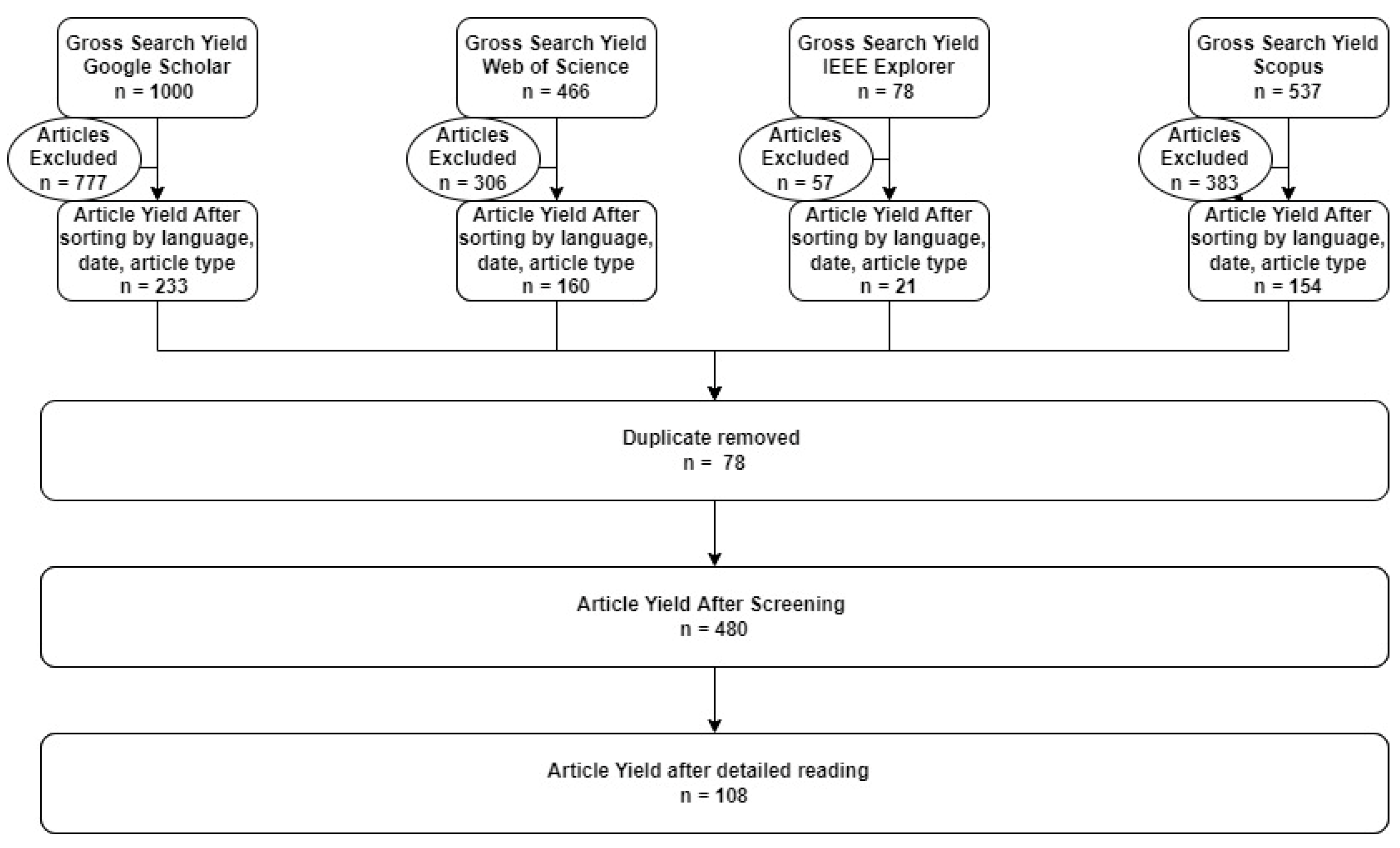
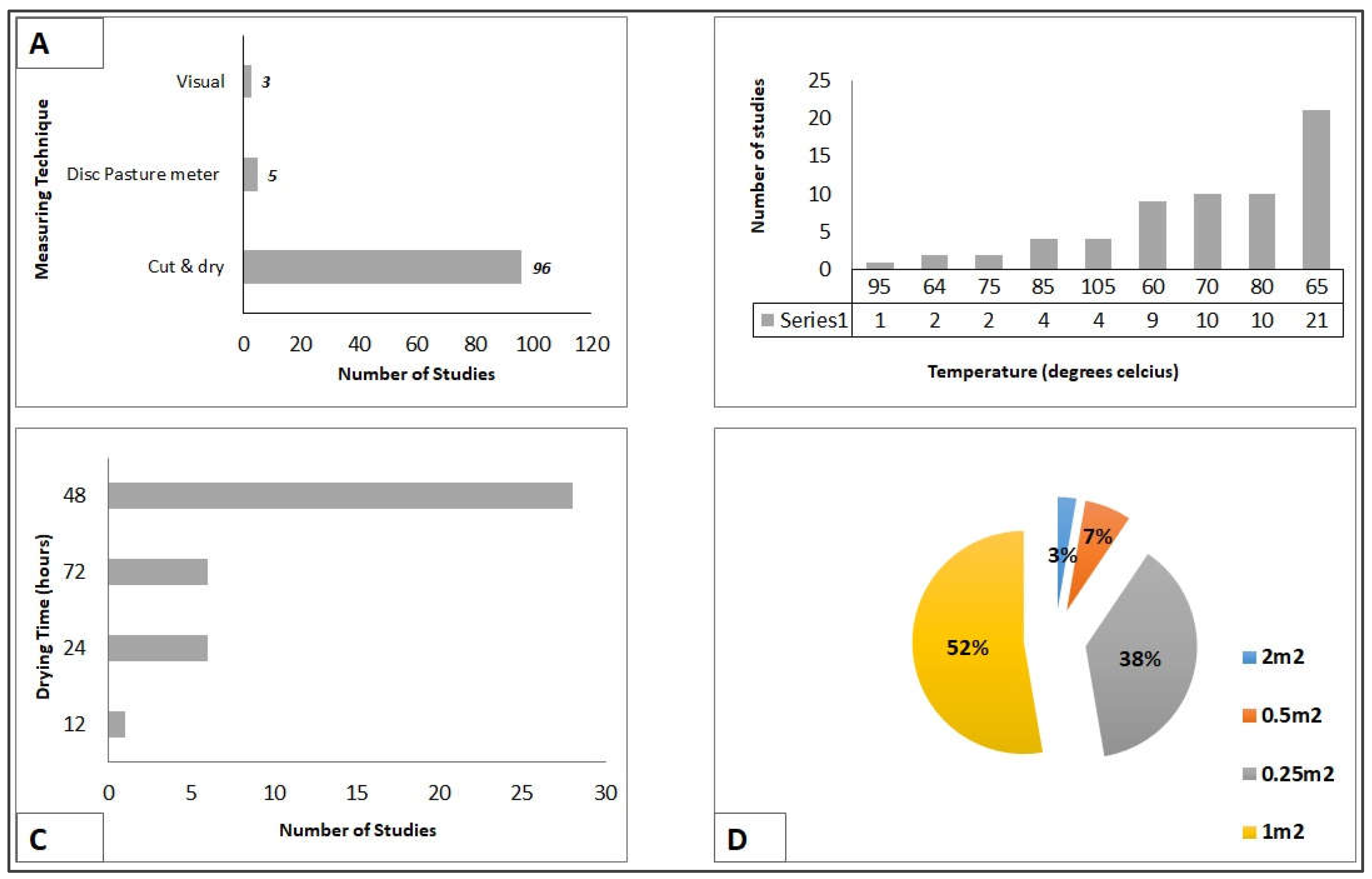
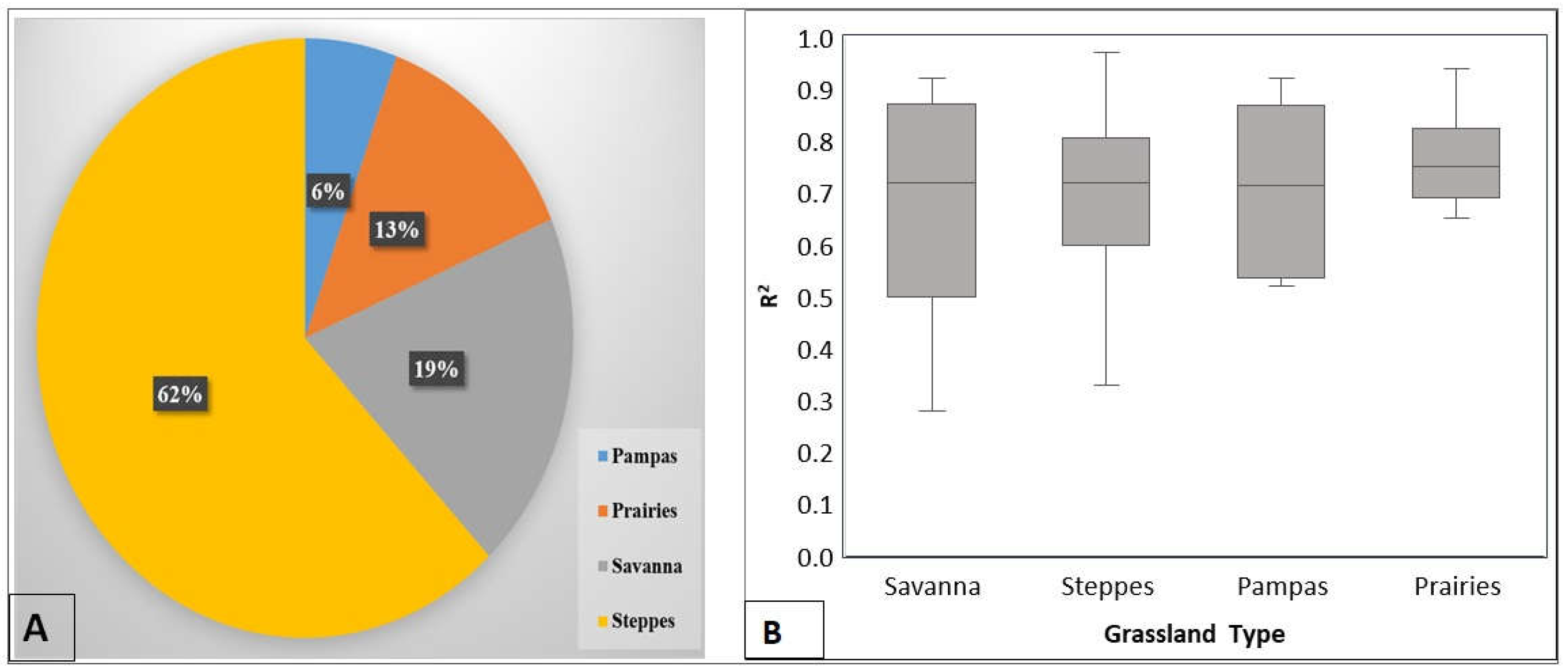
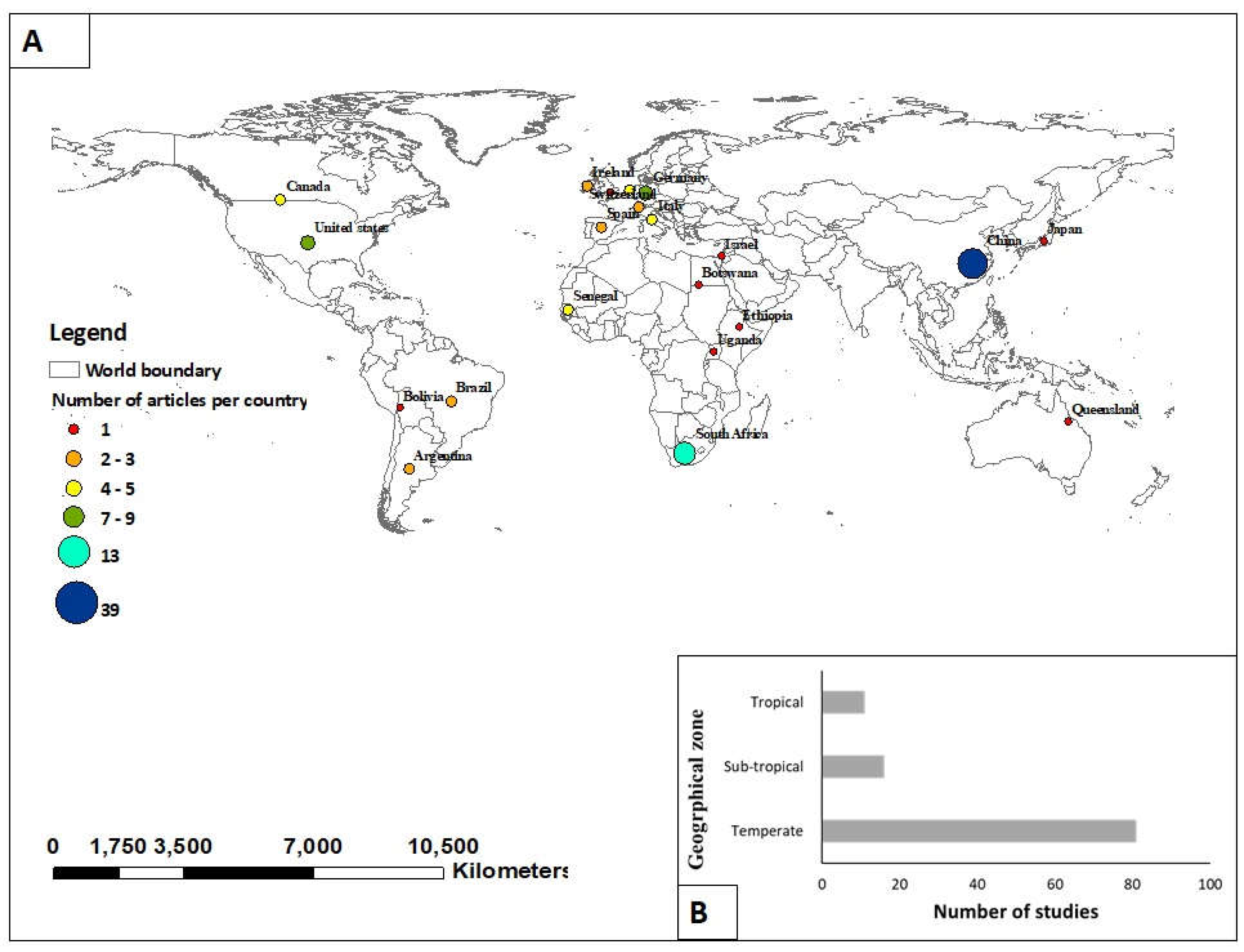
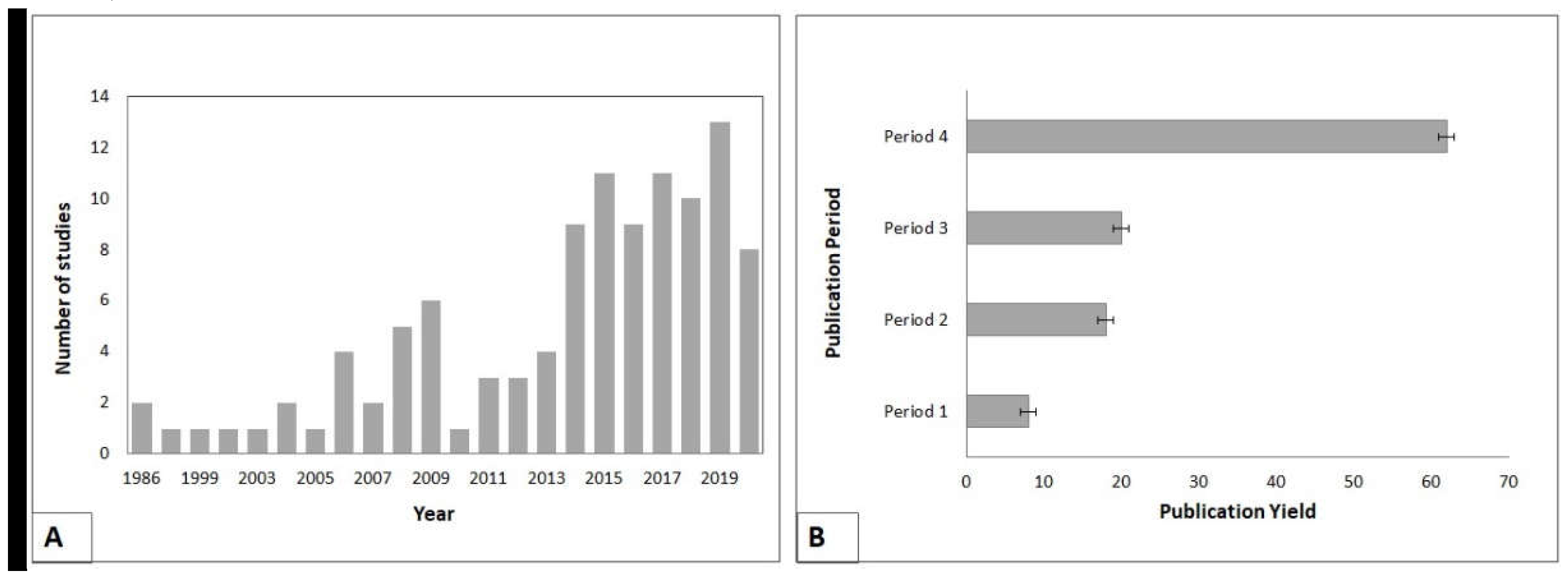

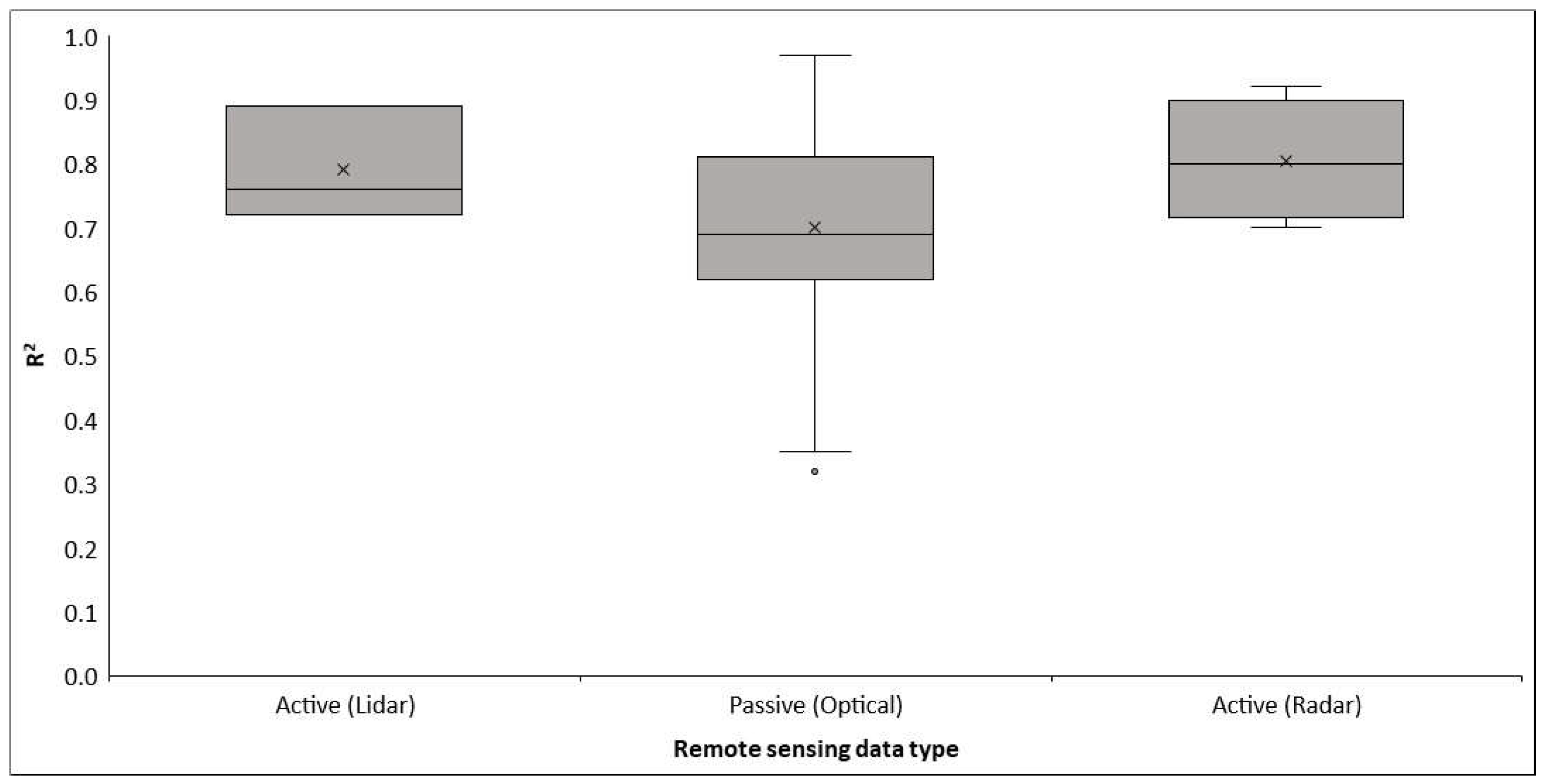
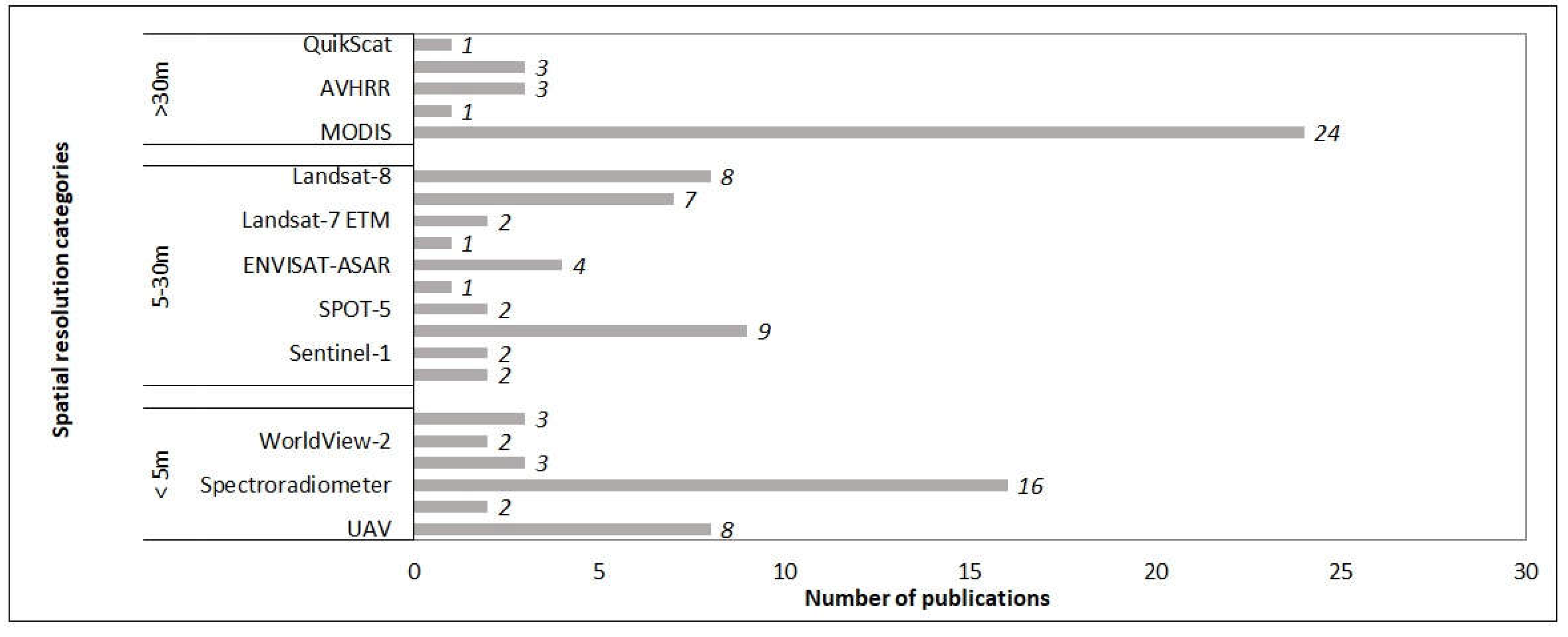

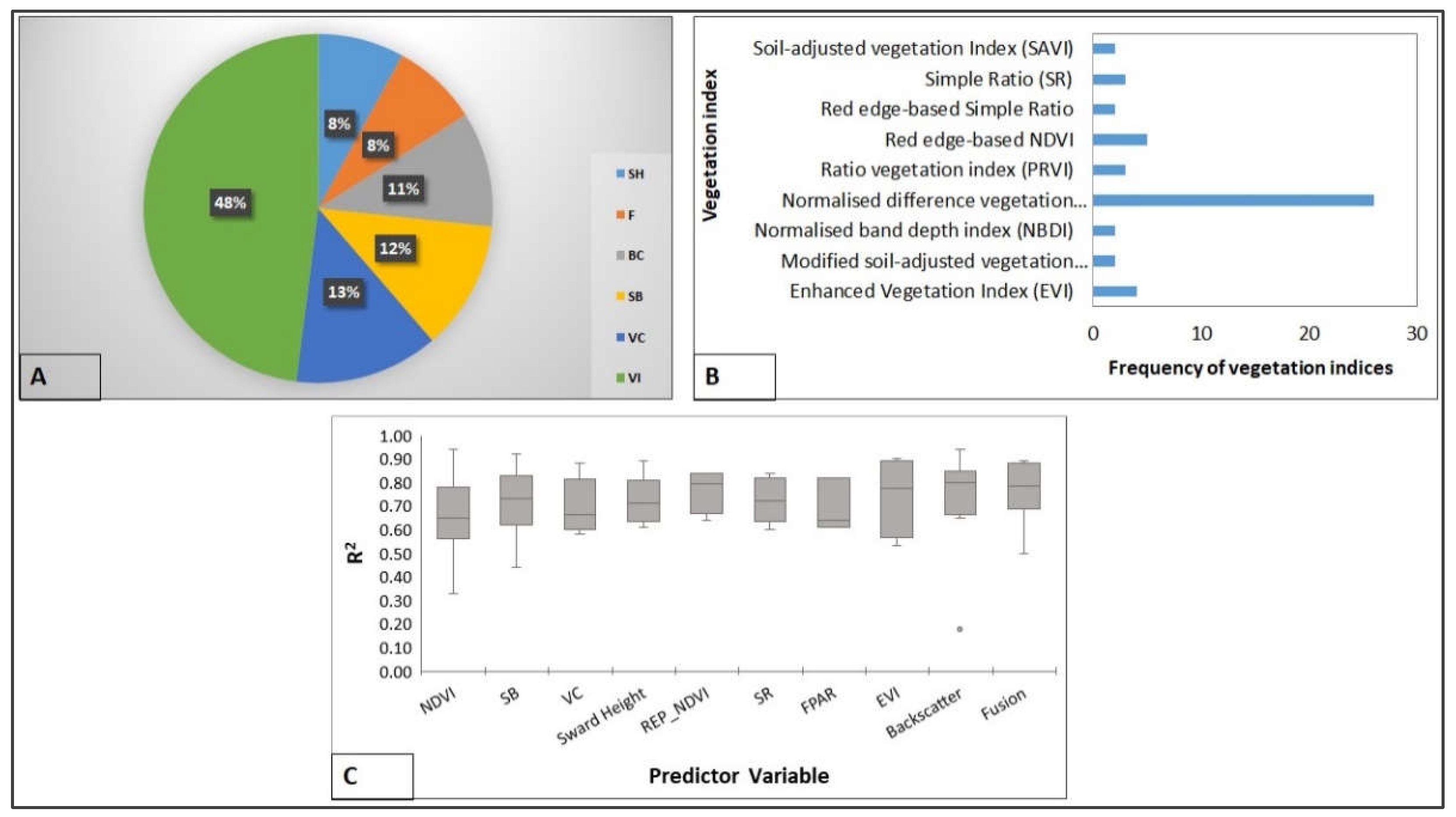

| Sensor | Number of Studies |
|---|---|
| MODIS | 23 |
| Spectroradiometer | 23 |
| Landsat 8 | 17 |
| Sentinel-2 | 13 |
| Landsat TM | 7 |
| AVHRR | 4 |
| Landsat-5 | 4 |
| Landsat-7 ETM+ | 4 |
| SPOT-5 | 4 |
| SPOT VGT | 4 |
| WorldView-2 | 4 |
| ENVISAT ASAR | 4 |
| UAV | 4 |
| WorldView-3 | 3 |
| Probav | 3 |
| Lidar | 3 |
| Sentinel -1 | 2 |
| TerraSAR-X | 2 |
| European Remote-Sensing (ERS-1) | 2 |
| ALOS PALSAR | 2 |
| HJ1B-CCD2 | 2 |
| COSMO-SkyMed (CSK) | 1 |
| Hyperion | 1 |
| Indian Remote Sensing | 1 |
| MERIS | 1 |
| HyMap | 1 |
| Apex | 1 |
| SMMI | 1 |
| Ultrasonic distance sensor | 1 |
| QuikScat | 1 |
| SPOT-4 | 1 |
| Digital camera | 1 |
| Authors | Sensors | Country | Grassland type |
|---|---|---|---|
| Sang et al. (2014) | ENVISAT-ASAR | China | Steppe |
| Moreau and Le Toan (2003) | ERS-ASAR | Bolivia | Savannah |
| Wang et al. (2014) | ENVISAT-ASAR & ALOS POLSAR | Australia | Pampas |
| Svoray and Shoshany (2002) | ERS-ASAR | Israel | Steppe |
| Hajj et al. (2014) | TERRA-X- ASAR & COSMO SKYMED | France | Steppe |
| Schmidt et al. (2016) | TERRA-X-ASAR | Queenswood | Steppe |
| Ali et al., (2017) | TERRA-X-ASAR | Ireland | Steppe |
| Bao et al. (2019) | Sentinel-1 | China | Pampas |
| Naidoo et al. (2019) | Sentinel-1 | South Africa | Savannah |
| Braun et al. (2018) | ENVISAT-ASAR, ALOS POLSAR & SSMI | Senegal | Savannah |
| Frolking et al. (2005) | SEA WIND | United States | Prairie |
| Wang et al. (2019) | Sentinel-1 | United States | Prairie |
| (Li and Guo, 2017) | RADARSAT | Canada | Prairie |
Disclaimer/Publisher’s Note: The statements, opinions and data contained in all publications are solely those of the individual author(s) and contributor(s) and not of MDPI and/or the editor(s). MDPI and/or the editor(s) disclaim responsibility for any injury to people or property resulting from any ideas, methods, instructions or products referred to in the content. |
© 2023 by the authors. Licensee MDPI, Basel, Switzerland. This article is an open access article distributed under the terms and conditions of the Creative Commons Attribution (CC BY) license (https://creativecommons.org/licenses/by/4.0/).





